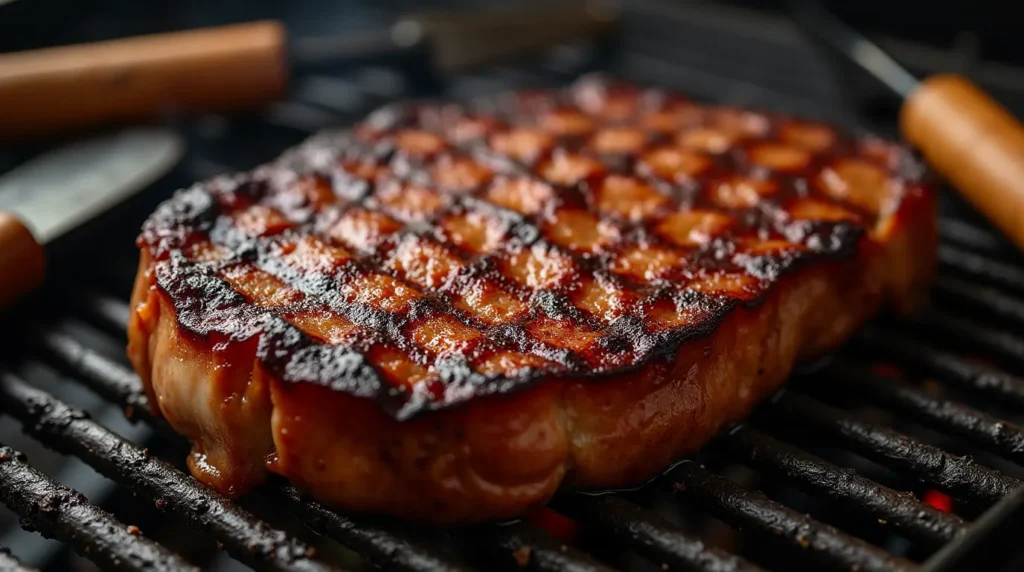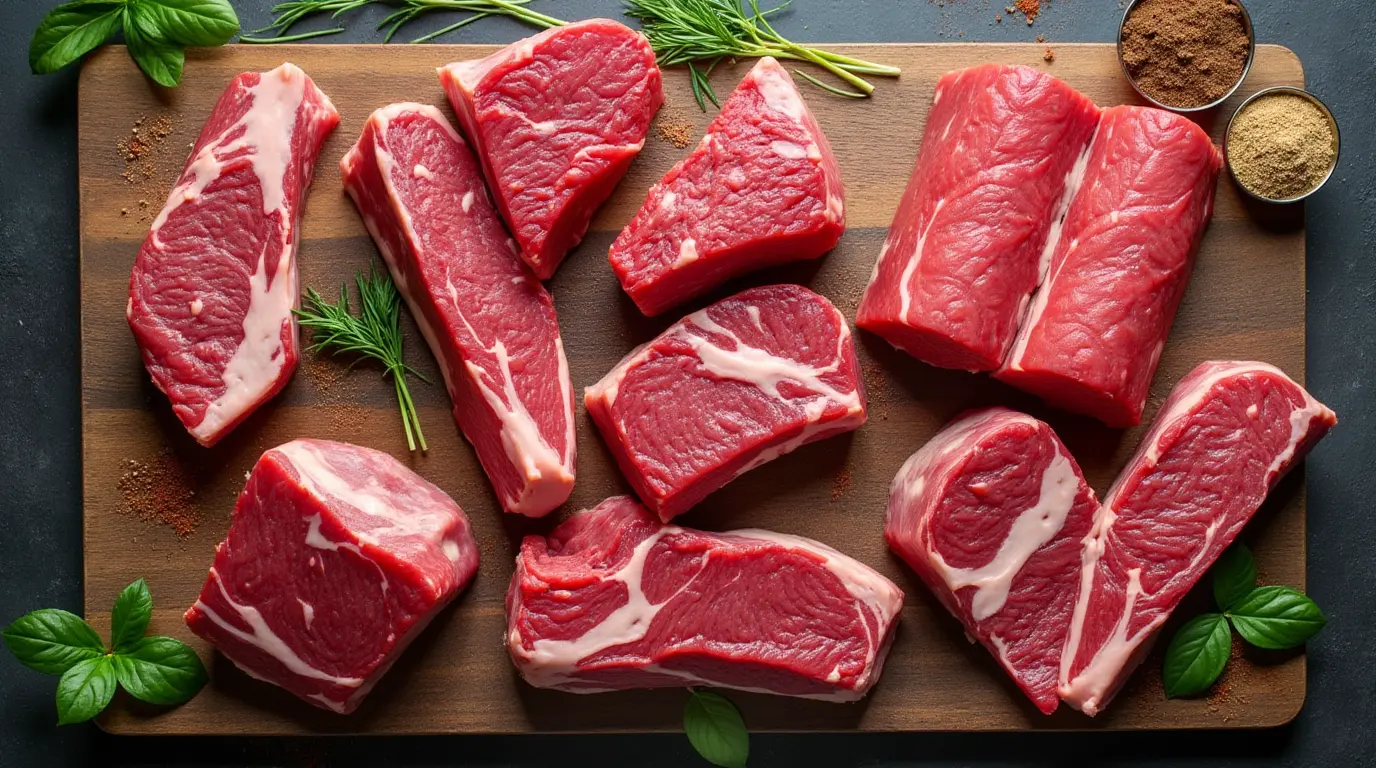Ever stood at the butcher counter wondering what to do with all those different beef cuts?
This guide breaks down the most common individual beef cuts, from tender ribeye to tough-but-flavorful chuck, and shows you exactly how to turn each one into a mouthwatering meal. Master the art of beef, one cut at a time.
Table of contents
What Are Individual Beef Cuts?
Beef cuts are segments of meat taken from a cow during butchering, categorized based on their location on the animal. These cuts fall into two broad groups: primary cuts (larger sections initially divided from the carcass) and secondary cuts (smaller, refined portions often found at stores).
Understanding these cuts is essential for anyone passionate about cooking, as each piece has its unique flavor profile, tenderness, and preferred preparation method. For example, the ribeye is renowned for its marbling, making it perfect for grilling, while the brisket’s robust texture shines when slow-cooked.
Why Understanding Beef Cuts Matters for Cooking and Dining
Choosing the right beef cut can make or break your dish. Ever tried grilling a piece of brisket? The results would likely be disappointing since it’s best suited for low-and-slow cooking. On the flip side, using tenderloin for a stew would be a waste of its delicate tenderness.
Understanding individual beef cuts ensures you pair the right cut with the ideal cooking technique, unlocking its full potential. Additionally, knowing your cuts can help you save money purchasing underrated or lesser-known cuts often delivers similar quality to premium cuts at a fraction of the price.
Overview of Primary Beef Cuts
What Are Primary Cuts of Beef?
When butchers process beef, they begin by dividing the carcass into large sections called primary cuts. These include the chuck, rib, loin, and round, which are the foundation for secondary or individual beef cuts. Each primary cut offers distinct characteristics:
- Chuck: Found in the shoulder area, this cut is ideal for braising due to its rich flavor and ample connective tissue.
- Rib: Known for its marbling and tenderness, cuts from the rib section are favorites for grilling and roasting.
- Loin: Positioned along the back of the cow, this area produces premium cuts like tenderloin and strip steak, renowned for their tenderness.
- Round: Taken from the hindquarters, the round is lean and affordable, perfect for roasting and slow cooking.
Understanding these primary cuts is key to navigating the wide array of individual beef cuts available.
Differences Between Primary and Secondary Cuts
Primary cuts are the starting point, but the magic happens when they are further broken down into smaller, more specific sections called secondary cuts. For example:
- From the rib, you get the ribeye and short ribs.
- The loin gives you tenderloin, strip steak, and T-bone.
- Chuck transforms into versatile cuts like chuck roast and flat iron steak.
Each secondary cut offers unique cooking properties, which we’ll explore in greater detail in the next section.
Detailed Breakdown of Popular Individual Beef Cuts
Cuts from the Chuck
- Chuck Roast: This budget-friendly cut is perfect for slow-cooking methods like braising, creating tender, flavorful dishes.
- Flat Iron Steak: A hidden gem from the chuck, it’s prized for its tenderness and is excellent for grilling or pan-searing.
Cuts from the Rib

- Ribeye Steak: Famous for its marbling, this steak is a go-to for grilling enthusiasts seeking rich, beefy flavor.
- Prime Rib: A show-stopping roast often reserved for special occasions, it’s celebrated for its juicy, tender texture.
Cuts from the Loin
- Tenderloin: The most tender cut of beef, it’s perfect for elegant dishes like filet mignon.
- Strip Steak: A versatile steak cut that balances tenderness and flavor, ideal for grilling or broiling.
- T-Bone: A combination of strip steak and tenderloin, offering the best of both worlds.
Cuts from the Round
- Top Round: Lean and affordable, it’s great for roasting or slicing thin for sandwiches.
- Eye of Round: Another economical option, this cut shines when slow-cooked or used for stir-fries.
Each of these individual beef cuts has its place in the culinary world, providing endless opportunities to experiment and savor.
Looking for more inspiration? Check out our Quick & Easy Recipes, great for turning these cuts into weekday winners.
Specialty and Lesser-Known Individual Beef Cuts
What Are Choice Cuts of Beef?
The term “choice cuts” refers to beef that meets specific USDA grading criteria. These cuts strike a balance between marbling and leanness, offering good tenderness, flavor, and juiciness. Examples of individual beef cuts under the “choice” grade include ribeye steaks, tenderloin, and T-bones.
Although they may lack the premium marbling of “prime” grade beef, choice cuts remain an excellent option for grilling, roasting, or searing. They’re more budget-friendly while still delivering delicious results.
Rare and Unique Cuts
Exploring lesser-known beef cuts can be a delightful culinary adventure:
- Hanger Steak: Known as the “butcher’s steak,” hanger steak is flavorful and prized for its tenderness. Due to its limited quantity per cow, it’s more expensive than common cuts.
- Tri-Tip: Cut from the bottom sirloin, tri-tip is versatile and well-suited for grilling or roasting. Its rich flavor makes it a favorite for barbecues.
- Denver Steak: This hidden gem from the chuck is tender, well-marbled, and ideal for pan-searing or grilling.
Trying these specialty cuts can elevate your home-cooked meals, offering something unique and memorable for the table.
Cooking Tips for Individual Beef Cuts
Pairing Cooking Methods with Beef Cuts
Knowing how to cook individual beef cuts ensures that each piece shines. Here’s a quick guide:
- Tender Cuts: Ribeye, tenderloin, and strip steak are ideal for grilling or searing, as they require minimal cooking time.
- Tougher Cuts: Chuck roast, brisket, and short ribs excel with slow-cooking techniques like braising or stewing, which break down connective tissues.
- Lean Cuts: Cuts like sirloin and top round benefit from marinades to enhance flavor and tenderness.
Matching the cooking method to the cut not only improves texture but also brings out the best flavor.
Common Mistakes to Avoid When Preparing Beef Cuts
Even the best cuts can underwhelm if prepared improperly. Avoid these common missteps:
- Skipping Rest Time: Always rest cooked beef for at least 5–10 minutes to allow the juices to redistribute.
- Overcooking: Use a meat thermometer to ensure you hit the right temperature without drying out the beef.
- Using the Wrong Cut for the Recipe: Ensure the cut suits the method brisket isn’t meant for quick grilling, and tenderloin doesn’t belong in a stew.
Mastering these tips can transform your beef dishes, making each meal more enjoyable and flavorful.
Want to balance your meal with a smart treat? Try our Healthy Baking Recipes, wholesome ideas for sweet finishes.
Choosing and Storing Individual Beef Cuts
How to Choose Fresh and High-Quality Cuts
Selecting the right individual beef cuts starts with knowing what to look for at the butcher or supermarket:
- Color: Fresh beef should have a vibrant red hue, though vacuum-sealed cuts may appear darker due to oxygen absence.
- Marbling: Look for white streaks of fat interspersed in the muscle. Good marbling enhances tenderness and flavor.
- Texture: The meat should feel firm and moist but not sticky or slimy.
- Grading: USDA grades like Prime, Choice, and Select indicate quality. Prime offers the best marbling, while Select is leaner and more economical.
Don’t hesitate to ask your butcher for advice they’re an excellent resource for finding the perfect cut for your recipe.
Proper Storage to Maintain Flavor and Safety
Once you’ve chosen your individual beef cuts, proper storage is essential:
- Refrigeration: Store fresh beef in the coldest part of your fridge and use it within 3–5 days. For ground beef, aim to cook it within two days.
- Freezing: Wrap beef tightly in plastic wrap and aluminum foil or vacuum seal it to prevent freezer burn. Most cuts can be frozen for 6–12 months.
- Thawing: Always thaw beef in the fridge or under cold running water. Avoid room-temperature thawing to reduce the risk of bacterial growth.
By following these tips, you can preserve the quality and flavor of your beef, ensuring it’s ready to shine in any dish.
For those who love rustic and traditional cooking, don’t miss Grandma’s Recipes, perfect for using classic cuts in timeless meals.
Frequently Asked Questions
What are the 7 primal cuts of beef?
The 7 primal cuts of beef are the large initial sections from which all other cuts are derived. They are:
Chuck – flavorful, good for slow cooking
Rib – home of the ribeye, tender and marbled
Loin – includes tenderloin and sirloin, prized for tenderness
Round – lean and tough, great for roasting
Brisket – rich and fatty, perfect for smoking or braising
Plate – where short ribs and skirt steak come from
Flank – lean and fibrous, ideal for grilling or stir-fries
These primal cuts are then broken down into subprimal and retail cuts for everyday use.
What is a petite cut of beef?
A petite cut of beef refers to a smaller, trimmed-down portion of a larger steak or roast. It’s often leaner and more manageable in size for individual servings.
Examples include:
Petite filet – a smaller cut from the tenderloin
Petite sirloin – a trimmed, lean sirloin portion
Petite chuck steak – cut thinner for quicker cooking
These cuts offer the same flavor and tenderness in a portion-friendly format, ideal for lighter meals or controlled portions.
What cuts of meat can you get out of a 1 2 of beef?
When you buy half a cow (½ beef), you get a variety of cuts across all primal sections. Typically, it yields around 100–125 pounds of meat, depending on the size and how it’s butchered. Here’s a general breakdown:
From the front half:
Chuck roasts & steaks
Ribeye steaks
Brisket
Short ribs
From the hind half:
Sirloin steaks
Tenderloin (filet mignon)
Top round, bottom round roasts
Flank and skirt steaks
Other common items:
Ground beef (from trim)
Soup bones & stew meat
Organ meats (optional: heart, liver, tongue)
Butchers will usually let you customize the cuts based on your cooking style and storage needs
What is the most underrated cut of beef?
One of the most underrated cuts of beef is the flat iron steak.
It’s:
Incredibly tender (second only to filet mignon)
Rich in beefy flavor
Affordable compared to premium cuts
Great for grilling, pan-searing, or slicing for salads and tacos
Other overlooked gems include chuck eye steak, hanger steak, and tri-tip — all flavorful, budget-friendly, and delicious when cooked right.

